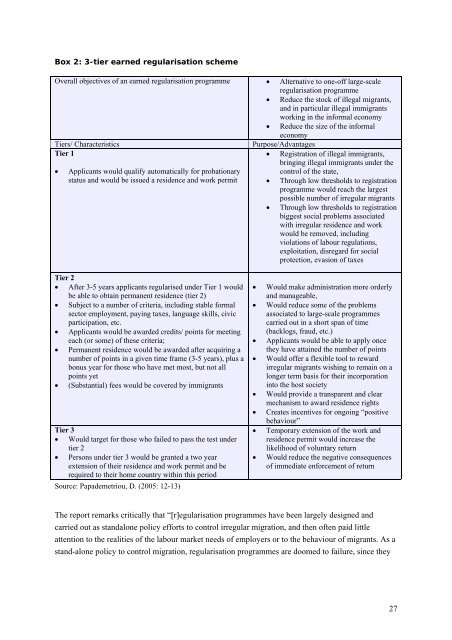REGINE Regularisations in Europe Final Report - European ...
REGINE Regularisations in Europe Final Report - European ...
REGINE Regularisations in Europe Final Report - European ...
Create successful ePaper yourself
Turn your PDF publications into a flip-book with our unique Google optimized e-Paper software.
Box 2: 3-tier earned regularisation scheme<br />
Overall objectives of an earned regularisation programme • Alternative to one-off large-scale<br />
regularisation programme<br />
• Reduce the stock of illegal migrants,<br />
and <strong>in</strong> particular illegal immigrants<br />
work<strong>in</strong>g <strong>in</strong> the <strong>in</strong>formal economy<br />
• Reduce the size of the <strong>in</strong>formal<br />
economy<br />
Tiers/ Characteristics<br />
Purpose/Advantages<br />
Tier 1<br />
• Applicants would qualify automatically for probationary<br />
status and would be issued a residence and work permit<br />
• Registration of illegal immigrants,<br />
br<strong>in</strong>g<strong>in</strong>g illegal immigrants under the<br />
control of the state,<br />
• Through low thresholds to registration<br />
programme would reach the largest<br />
possible number of irregular migrants<br />
• Through low thresholds to registration<br />
biggest social problems associated<br />
with irregular residence and work<br />
would be removed, <strong>in</strong>clud<strong>in</strong>g<br />
violations of labour regulations,<br />
exploitation, disregard for social<br />
protection, evasion of taxes<br />
Tier 2<br />
• After 3-5 years applicants regularised under Tier 1 would<br />
be able to obta<strong>in</strong> permanent residence (tier 2)<br />
• Subject to a number of criteria, <strong>in</strong>clud<strong>in</strong>g stable formal<br />
sector employment, pay<strong>in</strong>g taxes, language skills, civic<br />
participation, etc.<br />
• Applicants would be awarded credits/ po<strong>in</strong>ts for meet<strong>in</strong>g<br />
each (or some) of these criteria;<br />
• Permanent residence would be awarded after acquir<strong>in</strong>g a<br />
number of po<strong>in</strong>ts <strong>in</strong> a given time frame (3-5 years), plus a<br />
bonus year for those who have met most, but not all<br />
po<strong>in</strong>ts yet<br />
• (Substantial) fees would be covered by immigrants<br />
Tier 3<br />
• Would target for those who failed to pass the test under<br />
tier 2<br />
• Persons under tier 3 would be granted a two year<br />
extension of their residence and work permit and be<br />
required to their home country with<strong>in</strong> this period<br />
Source: Papademetriou, D. (2005: 12-13)<br />
• Would make adm<strong>in</strong>istration more orderly<br />
and manageable,<br />
• Would reduce some of the problems<br />
associated to large-scale programmes<br />
carried out <strong>in</strong> a short span of time<br />
(backlogs, fraud, etc.)<br />
• Applicants would be able to apply once<br />
they have atta<strong>in</strong>ed the number of po<strong>in</strong>ts<br />
• Would offer a flexible tool to reward<br />
irregular migrants wish<strong>in</strong>g to rema<strong>in</strong> on a<br />
longer term basis for their <strong>in</strong>corporation<br />
<strong>in</strong>to the host society<br />
• Would provide a transparent and clear<br />
mechanism to award residence rights<br />
• Creates <strong>in</strong>centives for ongo<strong>in</strong>g “positive<br />
behaviour”<br />
• Temporary extension of the work and<br />
residence permit would <strong>in</strong>crease the<br />
likelihood of voluntary return<br />
• Would reduce the negative consequences<br />
of immediate enforcement of return<br />
The report remarks critically that “[r]egularisation programmes have been largely designed and<br />
carried out as standalone policy efforts to control irregular migration, and then often paid little<br />
attention to the realities of the labour market needs of employers or to the behaviour of migrants. As a<br />
stand-alone policy to control migration, regularisation programmes are doomed to failure, s<strong>in</strong>ce they<br />
27
















